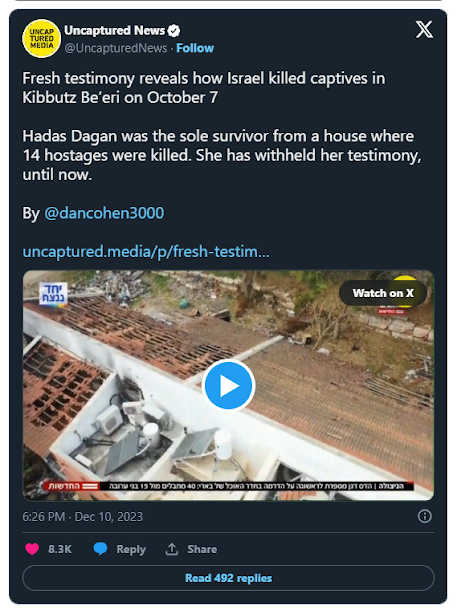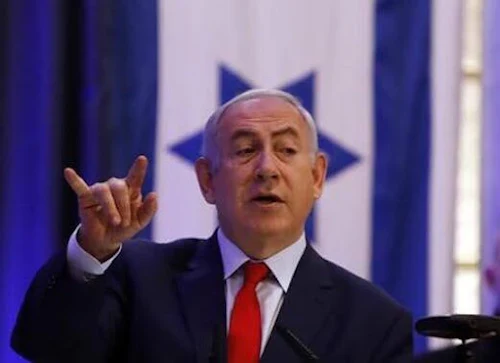Even the uninterested person can see that the Israeli settler land grab in the visual above has made the two state solution non-viable with the reduced and balkanized footprint in green. The Palestinians have been left so little to work with. There's no dignity, no mercy, no pragmatism and so much unkindness. I wish my words would persuade my Jewish friends that this course of events is folly and cheapens the history of persecution they have suffered. I don't understand why those most intimate with hate filled suffering are unable to see it when directed at others. I have no explanation that satisfies me when trying to answer this question. Nothing bipartisan and intelligent survives.
The speeches above are impervious to the suffering, but that doesn't mean they pretend the two state solution is alive. You can make your own mind up. The map and the hardcore Zionists tell the same story.
On October 10, 2012, Ehud Yaari and Nathan Brown addressed a Policy Forum at The Washington Institute. Ehud Yaari is a Lafer international fellow with The Washington Institute and Middle East correspondent for Israel's Channel Two television. Nathan Brown is a professor of political science and international affairs at George Washington University and a nonresident senior associate at the Carnegie Endowment, where he focuses on Islamist movements, Palestinian politics, and Arab law and constitutionalism. The following is a rapporteur's summary of their remarks.
EHUD YAARI
After almost twenty years of operating, the Palestinian Authority (PA) increasingly appears to be in existential jeopardy. More than three years after the inauguration of Prime Minister Salam Fayad's state-building plan, the PA is nearly bankrupt. Arab donors have failed to fulfill their financial pledges, private banks will no longer extend loans to the government, employee salaries have been deferred, and the deficit is effectively over $1.5 billion. As a result, Israeli prime minister Binyamin Netanyahu has been forced to advance the payment of customs revenues to the PA. According to the World Bank, donor contributions to the PA already constitute 50 percent of GDP, and recent World Bank reports further emphasize that economic growth is unsustainable without increased private-sector activity.
Originally, the PA was conceived as the vehicle for state building, the administrative nucleus of a future Palestinian state. Without evidence of substantial progress toward this goal, however, many have begun to question the need for the PA's existence. Indeed, Palestinians' views of the PA are increasingly negative, and many have sought to distance themselves from government involvement in local affairs. In Hebron, for instance, prominent figures have openly demanded that the PA-appointed governor refrain from unnecessary interference in local trade. In east Jerusalem, prominent families have asked that the PA-appointed governor, who resides outside the city, likewise refrain from interfering, and many seek to retain their Israeli blue cards. In Jenin, District Governor Qadura Musa died of a heart attack after his house was fired at by unknown assailants, and authorities have not dared to indict the perpetrators.
Against such a backdrop, PA president Mahmoud Abbas has asked his aides to review procedures for transferring power to the municipalities. While no concrete plan for dismantling the PA has been put in place, sentiments are overwhelmingly negative. Indeed, many among the Fatah district councils argue that the PA has allowed Israel to have an "occupation by proxy." While the appetite for launching another intifada is low, several other options have been suggested. First among them is that the PA be divorced from the obligations of the Oslo Accords. In such a shift, the PA would become a vehicle for changing the rules of the game rather than merely the product of a bilateral agreement, a notion supported by such figures as Nabil Shaath, Yasser Abd Rabbo, and Mahmoud al-Aloul. Others -- such as the highly respected Dr. Sari Nusseibeh -- have suggested a system in which the PA would become the autonomous center of a confederate state. This idea has little support among Palestinian intellectuals, however, or at the grassroots level. A few Palestinians have suggested that the PA confine its responsibilities to the West Bank and accept a confederal system with the Gaza Strip; this would improve the PA's economic situation, given that Prime Minister Fayad now claims to spend 58 percent of his budget in Gaza. Finally, in light of expected turbulence in Jordan, some have begun discussing the possibility of relinking the West Bank and Jordan through a special arrangement in which the West Bank would become a semiautonomous Jordanian wilayah. Some Jordanian officials have suggested openness to this idea.
Recent comments by President Abbas about his possible resignation have also raised questions about succession. Half the members of the Fatah Central Committee see themselves as possible contenders, including Muhammad Dahlan, now in exile in the United Arab Emirates, whose campaign has focused on Abbas's alleged corruption; Mahmoud al-Aloul, who comes from the hardcore terrorist apparatus of Fatah; the imprisoned Marwan Barghouti, who is not viewed as a serious candidate but could be chosen as a type of "president in absentia"; and Muhammad "Abu Maher" Ghneim or Sultan Abu al-Ainain, who both opposed Oslo from the beginning.
However bleak the portents, the preservation of the PA is indispensable to a two-state solution, and Israel must help prevent its collapse. Upcoming Israeli elections may lead to the formation of a more centrist government -- potentially a Likud-Labor coalition -- that could be open to taking important steps such as upgrading the PA's status or expanding the scope of its activities. In lieu of seeking a final-status agreement, Israel can best make progress through a generous interim deal, or "armistice," with the Palestinians. A number of Israeli political leaders, such as former Prime Minister Ehud Olmert or Defense Minister Ehud Barak, might favor such a solution.
NATHAN BROWN
From a Palestinian perspective, the PA was always intended to be the kernel of a Palestinian state. Those who criticized its establishment did so either because they doubted the two-state solution in general -- this came primarily from Hamas -- or because they believed that the PA itself would lead only to an internal autonomy plan rather than a full-fledged state. When international efforts failed to resonate with the Palestinian people throughout the late 1990s, this second critique gained traction, crystallizing into yet a third critique, which pointed out that through the PA, Palestinians had received all the attributes of Arab authoritarianism and none of the benefits of statehood. During the second intifada, however, the Palestinian leadership, aware of the implications of this critique and faced with the imminent collapse of the PA, sought reform. This would eventually culminate in the 2006 parliamentary elections and the subsequent civil war between Hamas and Fatah. The Fayad government represented an attempt to respond to these developments.
To outsiders, Fayad was perceived as both a symbol of Palestinian self-reliance and a vehicle for institution building. Domestically, however, these perceptions held little credibility: not only was the Fayad government completely fiscally dependent, but outsiders were only interested in dealing with Fayad and no one else. Nevertheless, Fayad was successful in reforming fiscal procedures, repairing traffic lights, and paying salaries on time. But such measures amounted merely to a recovery from the second intifada and not to the building of a state. Nevertheless, countless households rely on the institutions of the PA, and its collapse would make a significant impact.
One of the most striking aspects of the current debate among the Palestinians is not a rejection of the two-state solution but a shift in mentality from the active to the passive, whereby people wonder what will happen to them rather than what they can do to implement change. Such a mindset is reflected in the lack of a long-term strategy in the West Bank. A similar mentality exists in Gaza, where Hamas has opted to hunker down and wait until a better opportunity presents itself. Ironically, this means that both movements, founded explicitly to provide options to the Palestinian people, have chosen to wait for an external actor to alter the status quo.
Many additional questions have emerged with the Arab uprisings that have swept the Middle East. Despite several instances of widespread demonstrations, a similar rebellion has not occurred within the Palestinian context for several reasons, including lingering exhaustion from the second intifada, the absence of a specific target for protests, and the lack of a tactical focus. In contrast to many of the countries that have seen uprisings, political space has not collapsed in the West Bank or Gaza, meaning that calls for demonstrations have been viewed as political rather than revolutionary. Unrest among the Palestinians, therefore, culminated in the reconciliation efforts of 2011, and not broader systemic change.


















































